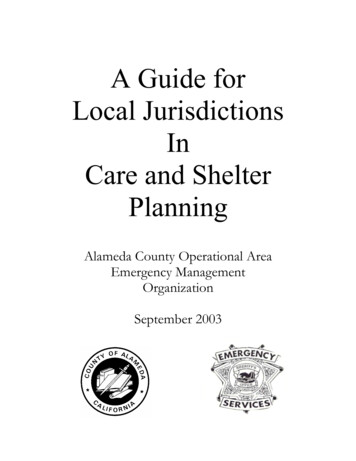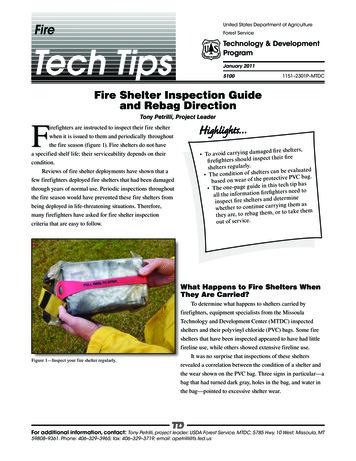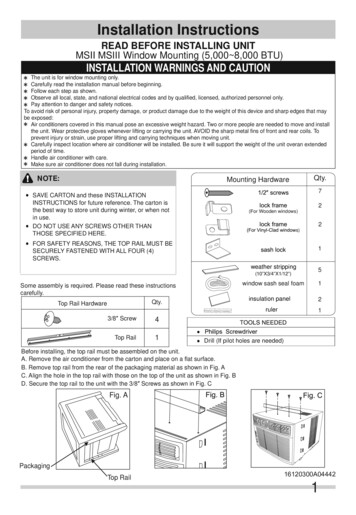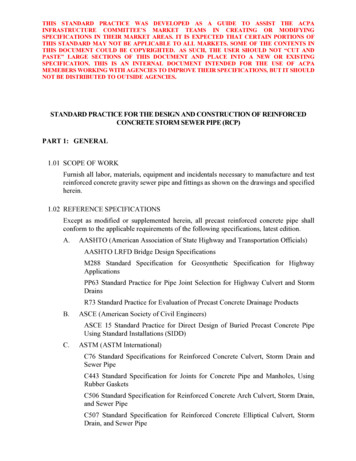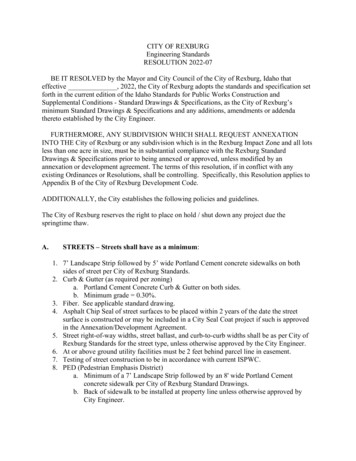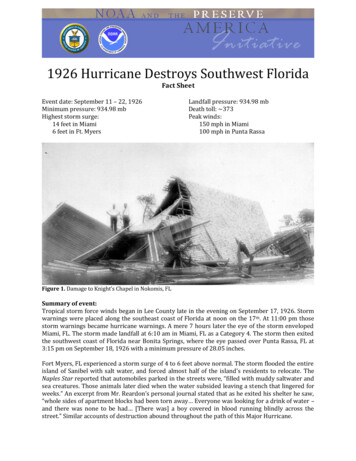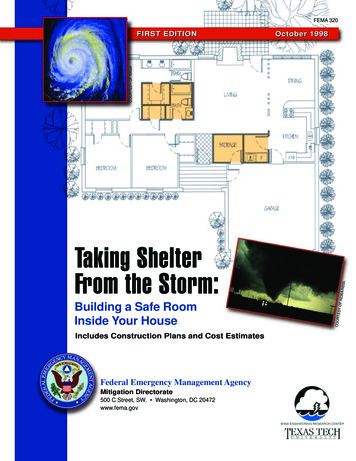
Transcription
FEMA 320October 1998Includes Construction Plans and Cost EstimatesFederal Emergency Management AgencyMitigation Directorate500 C Street, SW. Washington, DC 20472www.fema.govNOAA/NESY OFBuilding a Safe RoomInside Your HouseCOURTTaking ShelterFrom the Storm:SSLCOURTESY OF NASAFIRST EDITION
AcknowledgmentsThis booklet and the construction drawings it contains would not have been possiblewithout the pioneering work of the Wind Engineering Research Center at Texas Tech University,the diligent efforts of the design team, and the constructive suggestions of the reviewers.Design TeamReviewersPaul Tertell, P.E.Project OfficerProgram Policy and Assessment BranchMitigation DirectorateFEMAWashington, DCDennis LeeHurricane Program ManagerMitigation DivisionFEMA Region VIDenton, TexasClifford Oliver, CEMChief, Program Policy and Assessment BranchMitigation DirectorateFEMAWashington, DCBill MasseyHurricane Program ManagerMitigation DivisionFEMA Region IVAtlanta, GeorgiaDr. Ernst Kiesling, P.E.Professor of Civil EngineeringWind Engineering Research CenterTexas Tech UniversityLubbock, TexasTIm Sheckler, P.E.Civil EngineerNational Earthquake Program OfficeMitigation DirectorateFEMAWashington, DCDr. Kishor Mehta, P.E.Director, Wind Engineering Research CenterTexas Tech UniversityLubbock, TexasDr. Richard PetersonChairman, Department of GeosciencesTexas Tech UniversityLubbock, TexasRussell Carter, E.I.T.Research AssociateWind Engineering Research CenterTexas Tech UniversityLubbock, TexasLarry Tanner, P.E., R.A.Research AssociateWind Engineering Research CenterTexas Tech UniversityLubbock, TexasWilliam Coulbourne, P.E.Structural EngineerGreenhorne & O’Mara, Inc.Greenbelt, MarylandRichard Vognild, P.EDirector, Technical ServicesSouthern Building Code Congress InternationalBirmingham, AlabamaJay Crandell, P.E.Director, Structures and Materials DivisionNational Association of Home BuildersResearch CenterUpper Marlboro, MarylandRichard Carroll, P.E.Department of Buildings/InspectionsCity of BirminghamBirmingham, AlabamaJerry HoopingarnerProject EngineerNational Association of Home BuildersResearch CenterUpper Marlboro, MarylandBrad DouglasDirector of EngineeringAmerican Forest & Paper CompanyWashington, DCKen FordProgram Manager for Civil EngineeringNational Association of Home BuildersWashington, DC
Taking Shelter from the Storm:Building a Safe Room Inside Your HouseTable of ContentsIntroduction .iiiSection I: Understanding the HazardsWhat Is a Tornado? . 1Table I.1: Typical tornado damage . 2Figure I.1: The number of tornadoes recorded per1,000 square miles . 3What Is a Hurricane? . 4Table I.2: Typical hurricane damage. 4Do You Need a Shelter? . 5Figure I.2: Wind zones in the United States . 6Homeowner’s Worksheet . 7Emergency Planning and Emergency Supply Kit . 9Section II: Planning Your ShelterBuilding Damage . 11Figure II.1: Effect of extreme winds on building roofand walls . 11Basis of Shelter Design . 12Shelter Size .14New vs. Existing Houses . 14Foundation Types . 14Figure II.2: Cross-section: typical basementfoundation, with shelter. 15Figure II.3: Cross-section: typical slab-on-gradefoundation, with shelter. 17TAKING SHELTER FROM THE STORM: BUILDING A SAFE ROOM INSIDE YOUR HOUSEi
TABLE OF CONTENTSFigure II.4: Cross-section: typical crawlspacefoundation, with shelter. 18Shelter Location .20Figure II.5: Floor plan 1: basement .21Figure II.6: Floor plan 2: house on slab-on-gradeor crawlspace foundation. 22Figure II.7: Floor plan 3: house on slab-on-gradefoundation . 23Table II.1: Appropriate types of shelters fornew houses .24Table II.2: Appropriate types of shelters forexisting houses . 24Construction Materials . 25Shelter Cost .25Table II.3: Average cost for an 8-foot by 8-footshelter in a new house . 26Section III: Building Your Shelter . 27How To Use the Drawings . 28iiFEDERAL EMERGENCY MANAGEMENT AGENCY
IntroductionEvery year, tornadoes, hurricanes, and other extreme windstorms injure andkill people, and damage millions of dollars worth of property in the United States.Even so, more and more people build houses in tornado- and hurricane-proneareas each year, possibly putting themselves into the path of such storms.Having a shelter, or a safe room, built into your house can help youprotect yourself and your family from injury or death caused by the dangerousforces of extreme winds. It can also relieve some of the anxiety created by thethreat of an oncoming tornado or hurricane.Should you consider building a shelter in your house to protect yourselfand your family during a tornado or hurricane? The answer depends on youranswers to many questions, including: Do you live in a high-risk area? How quickly can you reach safe shelterduring extreme winds? What level of safety do you want toprovide? What is the cost of a shelter?This booklet will help you answer these and other questions so you candecide how best to protect yourself and your family. It includes the results ofresearch that has been underway for more than 20 years, by Texas TechUniversity’s Wind Engineering Research Center (WERC) and other windengineering research facilities, on the effects of extreme winds on buildings.This booklet also provides shelter designs that will show youand your builder/contractor how to construct a shelter underneatha new house, in the basement of a new house, or in an interiorroom of a new house, or how to modify an existing house to add ashelter in one of these areas. These shelters are designed toprotect you and your family from the high winds expected duringtornadoes and hurricanes and from flying debris, such as woodstuds, that tornadoes and hurricanes usually create.IMAGES COURTESY OF NOAA/DEPARTMENT OF COMMERCEThe National Association of Home Builders (NAHB) Research Centerhas evaluated these designs for construction methods, materials, and costs.Engineers at Texas Tech University have confirmed the design requirementsfor the expected forces from wind pressure and the impact of typical flyingdebris. The shelters are designed with life safety as the primary consideration.TAKING SHELTER FROM THE STORM: BUILDING A SAFE ROOM INSIDE YOUR HOUSEiii
Section I:Understanding theHazardsCOURTESY OF NASASatellite picture ofHurricane Andrewtaken August 25,1992Almost every state in theUnited States has been affectedby extreme windstorms such astornadoes and hurricanes.Virtually every state has beenaffected by a “considerable”tornado (see the terms in TableI.1). All Atlantic and Gulf ofMexico coastal areas in theUnited States – including coastalareas of Puerto Rico and the U.S. Virgin Islands – and coastal areas ofHawaii have been affected by hurricanes. Even in states not normallyconsidered to be susceptible to extreme windstorms there are areas thatexperience dangerous high winds. These areas are typically near mountainranges, and include the Pacific Northwest coast.What Is a Tornado?COURTESY OF NOAA, NATIONAL SEVERESTORMS LABORATORY (NSSL)Tornadoes are categorizedby the Fujita scale (see Table I.1).They typically occur in the springand summer months, but canoccur at any time in any part ofthe country. Tornadoes aresometimes spawned byhurricanes.On May 26, 1981, a tornadomoved through Dallas, TexasTAKING SHELTER FROM THE STORM: BUILDING A SAFE ROOM INSIDE YOUR HOUSE1
SECTION ITable I.1Typical tornadodamageUNDERSTANDING THE HAZARDSCategory / Typical DamageF0 Light: Chimneys are damaged, treebranches are broken, shallow-rooted trees aretoppled.F1 Moderate: Roof surfaces are peeled off,windows are broken, some tree trunks aresnapped, unanchored mobile homes areoverturned, attached garages may bedestroyed.F2 Considerable: Roof structures aredamaged, mobile homes are destroyed, debrisbecomes airborne (missiles are generated),large trees are snapped or uprooted.DEFINITIONIn this guide, thetermmissilesrefers to debris andother objects pickedup by the wind andmoved with enoughforce to damageand even penetratewindows, doors,walls, and otherparts of a building.In general, thestronger the wind,the larger andheavier the missilesit can carry and thegreater the risk ofsevere damage.But even smallstones, branches,and other lightermissiles can easilybreak glass doorsand windows.2F3 Severe: Roofs and some walls are torn fromstructures, some small buildings are destroyed,non-reinforced masonry buildings are destroyed,most trees in forest are uprooted.F4 Devastating: Well-constructed houses aredestroyed, some structures are lifted fromfoundations and blown some distance, cars areblown some distance, large debris becomesairborne.F5 Incredible: Strong frame houses are liftedfrom foundations, reinforced concrete structuresare damaged, automobile-sized missilesbecome airborne, trees are completelydebarked.F0, F1, AND F2 IMAGES COURTESY OF ANDREW DEVANAS, FLORIDA DIVISION OF EMERGENCY MANAGEMENTF3, F4, AND F5 IMAGES COURTESY OF NOAA, NATIONAL SEVERE STORMS LAOBORATORY (NSSL)Not all parts of each state are at equal risk from tornadoes. For example,while Texas has the highest number of recorded tornadoes, the state’s leasttornado-prone area—along the Gulf Coast—has been hit by fewer tornadoesthan northeastern Arkansas. Comparing the numbers of tornadoes recordedin different areas within a state can give you a better understanding of thepotential tornado activity in those areas. Figure I.1 shows the numbers oftornadoes recorded per 1,000 square miles in the United States and itspossessions and territories.FEDERAL EMERGENCY MANAGEMENT AGENCY
UNDERSTANDING THE HAZARDSFigure I.1The number of tornadoes recorded per 1,000 square milesSECTION ITAKING SHELTER FROM THE STORM: BUILDING A SAFE ROOM INSIDE YOUR HOUSE3
SECTION IUNDERSTANDING THE HAZARDSWhat Is a Hurricane?Hurricanes are categorized by the Saffir-Simpson scale (see Table I.2).Table I.2Typical hurricanedamageCategory / Typical DamageC1 Minimal: Damage is done primarily toshrubbery and trees, unanchored mobile homesare damaged, some signs are damaged, no realdamage is done to structures.C2 Moderate: Some trees are toppled, someroof coverings are damaged, major damage isdone to mobile homes.C3 Extensive: Large trees are toppled, somestructural damage is done to roofs, mobilehomes are destroyed, structural damage is doneto small homes and utility buildings.C4 Extreme: Extensive damage is done toroofs, windows, and doors; roof systems onsmall buildings completely fail; some curtainwalls fail.C5 Catastrophic: Roof damage isconsiderable and widespread, window and doordamage is severe, there are extensive glassfailures, some complete buildings fail.C1, C2, C3, C4 IMAGES: FEMAC5 IMAGE COURTESY OF NOAA, HISTORICAL DATA COLLECTIONIn the United States, 158 hurricanes were recorded to have madelandfall between 1900 and1996. Hurricanes have made landfall in Floridamore than in any other state. The second most hurricane-affected state isTexas, but every state on the Gulf Coast and bordering the Atlantic Ocean,as well as U.S. island possessions and territories, are susceptible todamage caused by hurricanes.In recent years, the U.S. territories of American Samoa and Guam havebeen seriously affected by numerous tropical cyclones.4FEDERAL EMERGENCY MANAGEMENT AGENCY
SECTION IUNDERSTANDING THE HAZARDSDo You Need a Shelter?On the basis of 40 years of tornado history and more than 100 years ofhurricane history, the United States has been divided into four zones thatgeographically reflect the number and strength of extreme windstorms. FigureI.2 shows these four zones. Zone IV has experienced the most and thestrongest tornado activity. Zone III has experienced significant tornado activityand includes coastal areas that are susceptible to hurricanes.To learn more about the wind history for the area where you live, checkwith your local building official, meteorologist, emergency managementofficial, or television weather reporter.Your house is probably built in accordance with local building codes thatconsider the effects of minimum, “code-approved” design winds in your area.Building codes require that buildings be able to withstand a “design” windevent. A tornado or extreme hurricane can cause winds much greater thanthose on which local code requirements are based. Having a house built to“code” does not mean that your house can withstand wind from any event, nomatter how extreme. The shelter designs in this booklet provide a place toseek safe shelter during these extreme wind events.The worksheet on pages 7 and 8 will help you determine your level ofrisk from these extreme events and will assist you in your consideration of ashelter. If you decide that you need a shelter, Section II will help you andyour builder/contractor plan your shelter.WARNINGDEFINITIONIn this guide, theterm storm surgerefers to the rise inthe level of theocean that resultsfrom the effects ofwind and the drop inatmospheric pressure associatedwith hurricanes andother storms.A shelter designed to protect you and your family from a hurricaneshould not be built in an area expected to be flooded during a hurricane. Residents of these hazardous coastal areas should abide bythe warnings of their local emergency services personnel and evacuate to safer ground. The protection from wind provided by safe roomsand shelters is quickly negated when stranded homeowners find themselves trapped by flood waters.If you do not know whether your house is in a storm surge area orother area subject to flooding, check the community service sectionof your local phone book for storm surge evacuation information orask your local emergency management or floodplain managementofficial.TAKING SHELTER FROM THE STORM: BUILDING A SAFE ROOM INSIDE YOUR HOUSE5
UNDERSTANDING THE HAZARDSFigure I.2Wind zones in the United StatesSECTION I6FEDERAL EMERGENCY MANAGEMENT AGENCY
Homeowner’sWorksheet:Assessing Your RiskTo complete the worksheet on the back of this page, refer to the tornado and wind zone mapson pages 3 and 6 (Figures I.1 and I.2). Using the map on page 3, note how many tornadoes wererecorded per 1,000 square miles for the area where you live. Find the row on the worksheet thatmatches that number. Next, look at the map on page 6 and note the wind zone (I, II, III, or IV) inwhich you live. Find the matching column on the worksheet. Finally, find the box inside theworksheet that lines up with both the number of tornadoes per 1,000 square miles in your area andyour wind zone. The color of that box tells you the level of your risk from extreme winds and helpsyou decide whether to build a shelter.For example, if you live in Jackson,Mississippi, you would see that Jackson is inan area shaded medium orange on the map onpage 3. So according to the map key, thenumber of tornadoes per 1,000 square miles inthe Jackson area is 11 – 15.On the map on page 6, Jackson appearswithin the red-shaded area. The map key tellsyou that Jackson is in Wind Zone IV.The box where the 11-15 row and the Zone IVcolumn meet is shaded dark blue, which showsthat you live in an area of high risk. A shelter isthe preferred method of wind protection inhigh-risk areas. Note that some areasof low or moderate risk, shown aspale blue or medium blue in theworksheet, are within the region ofthe United States that is subject tohurricanes (see Figure I.2). If youlive in this hurricane-susceptibleregion, your risk is considered high,even if the worksheet indicatesonly a moderate or low risk.TAKING SHELTER FROM THE STORM: BUILDING A SAFE ROOM INSIDE YOUR HOUSE7
ASSESSING YOUR RISK8FEDERAL EMERGENCY MANAGEMENT AGENCY
ASSESSING YOUR RISKEmergency Planning and Emergency Supply KitWhether or not you decide that you need a shelter in your house, you cantake two important steps to protect yourself and your family during a hurricaneor tornado: prepare an emergency plan and put an emergency supply kittogether. If you decide to build a shelter, your emergency plan should includenotifying local emergency managers and family members or others outside theimmediate area that you have a shelter. This will allow emergency personnel toquickly free you if the exit from your shelter becomes blocked by debris. Youshould also prepare an emergency supply kit and either keep it in your shelteror be ready to bring it with you if you need to evacuate your house. Some of theitems that the emergency supply kit should include are: an adequate supply of water for each person in your household non-perishable foods that do not have to be prepared or cooked(if these include canned goods, remember to bring a can opener) a first-aid kit, including necessary prescription medicines tools and supplies:– flashlight (do not bring candles or anything that lights with a flame)– battery-operated radio– cellular phone or CB radio– extra batteries– wrench (to turn off household gas and water)– clothing and bedding special items:– for baby— formula, diapers, bottles, powdered milk– for adults— contact lenses and supplies, extra glassesYou can get more information about emergency planning from AmericanRed Cross (ARC) and FEMA publications, which you can obtain free ofcharge by calling FEMA at 1-800-480-2520, or by writing to FEMA, P.O. Box2012, Jessup, MD 20794-2012. These publications include the following:Emergency Preparedness Checklist, FEMA L-154 (ARC 4471)Food and Water in an Emergency, FEMA L-164 (ARC 5055)Your Family Disaster Supplies Kit, FEMA L-189 (ARC 4463)Preparing for Emergencies, A Checklist for People with MobilityProblems, FEMA L-154 (ARC 4497)These publications are also available on the World Wide Web at theFEMA web site – http://www.fema.gov – and at the American Red Cross website – http://www.redcross.org.TAKING SHELTER FROM THE STORM: BUILDING A SAFE ROOM INSIDE YOUR HOUSE9
Section II:Planning Your ShelterNow that you better understand your risk from a tornado or hurricane,you can work with your builder/contractor to build a shelter to protect yourselfand your family from these extreme windstorms. This section describes howextreme winds can damage a building, explains the basis of the shelterdesigns presented in this booklet, and shows where you can build a shelter inyour house.Building DamageExtreme winds can cause several kinds of damage to a building. Figure II.1shows how extreme winds affect a building and helps explain why thesewinds cause buildings to fail.To understand what happens when extreme winds strike, you must firstunderstand that tornado and hurricane winds are not constant. Wind speeds,even in these extreme wind events, rapidly increase and decrease. Anobstruction, such as a house, in the path of the wind causes the wind tochange direction. This change in wind direction increases pressure on parts ofthe house. The combination of increased pressures and fluctuating windspeeds creates stress on the house that frequently causes connectionsbetween building components to fail. For example, the roof or siding can bepulled off or the windows can be pushed in.Figure II.1Effect of extreme winds on building roof and wallsTAKING SHELTER FROM THE STORM: BUILDING A SAFE ROOM INSIDE YOUR HOUSE11
SECTION II PLANNING YOUR SHELTERBuildings that fail under the effects of extreme winds often appear tohave exploded, giving rise to the misconception that the damage is caused byunequal wind pressures inside and outside the building. This misconceptionhas led to the myth that during an extreme wind event, the windows anddoors in a building should be opened to equalize the pressure. In fact,opening a window or door allows wind to enter a building and increases therisk of building failure.Damage can also be caused by flying debris (referred to as windbornemissiles). If wind speeds are high enough, missiles can be thrown at abuilding with enough force to penetrate windows, walls, or the roof. Forexample, an object such as a 2” x 4” wood stud weighing 15 pounds, whencarried by a 250-mph wind, canhave a horizontal speed of 100mph and enough force topenetrate most commonbuilding materials used inhouses today. Even areinforced masonry wall will bepenetrated unless it has beendesigned and constructed toresist debris impact duringextreme winds. Becausemissiles can severely damageand even penetrate walls androofs, they threaten not onlybuildings but the occupantsas well.Palm tree pierced by plywood missile, Hurricane AndrewBasis of Shelter DesignThe purpose of a shelter is to provide a space where you and your familycan survive a tornado or hurricane with little or no injury. In hurricane-proneareas, the shelter cannot be built where it can be flooded during a hurricane.Your shelter should be readily accessible from all parts of your house, and itshould be free of clutter. To protect the occupants during extreme windstorms,the shelter must be adequately anchored to the house foundation to resistoverturning and uplift. The connections between all parts of the shelter mustbe strong enough to resist failure, and the walls, roof, and door must resistpenetration by windborne missiles.Extensive testing by Texas Tech University and other wind engineeringresearch facilities has shown that walls, ceilings, and doors commonly used inhouse construction cannot withstand the impact of missiles carried by12FEDERAL EMERGENCY MANAGEMENT AGENCY
SECTION II PLANNING YOUR SHELTERextreme winds. The shelter designs in this booklet account for these findingsby specifying building materials and combinations of building materials thatwill resist penetration by missiles in extreme winds.Missile (debris)launcher, WindEngineeringResearch Center(WERC), Texas TechUniversityThe shelter designs,including both materials andconnections, are based onwind speeds that are rarelyexceeded in the UnitedStates. Therefore, a shelterbuilt according to thesedesigns is expected towithstand the forcesimposed on it by extremewinds without failing. Thoseforces may cause cracks orother signs of stress in thematerials or connectionsused in the shelter, and they may cause materials or connections to yield.However, the intent of the designs is not to produce a shelter that will alwaysremain completely undamaged, but rather a shelter that will enable itsoccupants to survive an extreme windstorm with little or no injury.It is very important to note that predicting the exact strength of tornadoesand hurricanes is impossible. That is another reason why the shelter designsin this booklet are based on extreme wind speeds and why the primaryconsideration is life safety.2" x 4" wood studlaunched at 100mph piercesunreinforcedmasonry wall,WERC, Texas TechUniversityDesigning a building to resist damage from more than one naturalhazard requires different, sometimes competing, approaches. For example,building a structure on an elevated foundation to raise it above expectedflood levels can increase its vulnerabilityto wind and seismic damage. Thesedesign approaches need to bethoroughly considered. In floodproneareas, careful attention should be given tothe warning time, velocity, depth, andduration of flood waters. These floodingcharacteristics can have a significantbearing on the design and possibly eventhe viability of a shelter. Your localbuilding official or licensed professionalengineer or architect can provide youwith information about other naturalhazards that affect your area and canrecommend appropriate designs.TAKING SHELTER FROM THE STORM: BUILDING A SAFE ROOM INSIDE YOUR HOUSE13
SECTION II PLANNING YOUR SHELTERShelter SizeThe amount of floor area per person that your shelter must providedepends partly on the type of windstorm the shelter is intended to protect youfrom. Tornadoes are not long-lasting storms, so if you are relying on yourshelter only for tornado protection, you will not need to stay in the shelter for along time. As a result, comfort is not of great concern, and a shelter thatprovides about 5 square feet of floor area per person will be big enough.When the shelter is intended to provide protection from storms such ashurricanes, which can last up to 12 hours, the comfort of the occupantsshould be considered. For this type of shelter, the recommended amount offloor area per person is about 10 square feet. Necessities, such as water andtoilet facilities, should be provided. The shelter designs in this booklet arebased on a maximum floor area of 64 square feet and a maximum wall lengthof 8 feet. A shelter of that size used for hurricane protection canaccommodate up to six people in reasonable comfort. If you plan to build ashelter with any wall longer than 8 feet, consult a licensed professionalengineer or architect.NOTEThe shelter designsin this booklet areapplicable for anyon-site construction. However, in amodular house, theshelter locationwould be limited tothe basement orthe belowgroundmodule. A modularhouse is a houseconstructedofmodular units thathave been builtelsewhere, broughtto the site, and installed on a permanent foundation.14New vs. Existing HousesThe shelter designs in this booklet were developed primarily for use in newhouses, but some can be used in existing houses. When a new house is beingbuilt, the builder/contractor can construct walls, foundations, and other parts ofthe house as required to accommodate the shelter. Modifying the walls orfoundation of an existing house as necessary for the construction of a shelter ismore difficult. As a result, some of the shelter designs in this booklet are notpractical for existing houses. The following sections discuss this issue further.In this booklet, the term “retrofit” refers to the process of making changesto an existing house.Foundation TypesHouses on the following types of foundations are suitable for theinstallation of a shelter: basement slab-on-grade crawlspaceA house on a basement foundation (see Figure II.2) is usually built on afoundation constructed of poured concrete or concrete masonry. Mostconcrete foundations are reinforced with steel bars or straps, but manyconcrete masonry foundation walls have no steel reinforcement. The framingfor the floor above the basement is supported by the exterior foundation wallsand sometimes by a center beam.FEDERAL EMERGENCY MANAGEMENT AGENCY
SECTION II PLANNING YOUR SHELTERFigure II.2Cross-section:typical basementfoundation, withshelterIn a new or existing house with a basement, the shelter should be built inthe basement. You can build the shelter as an entirely separate structure withits own walls, or you can use one or more of the basement walls as walls ofthe shelter. If you use the basement walls, they will have to be speciallyreinforced. Typical reinforcement techniques used in residential basementwalls will not provide sufficient protection from missiles. In new construction,your builder/contractor can reinforce the walls near the shelter during theconstruction of your house. Reinforcing the basement walls of an existinghouse is not practical.The likelihood of missiles entering the basement is lower than for aboveground areas; however, there is a significant chance that missiles or fallingdebris will enter the basement through an opening left when a window, a door,or the first floor above has been torn off by extreme wind. Therefore, yourbasement shelter must have its own reinforced ceiling; the basement ceiling(the first floor above) cannot be used as the ceiling of the shelter.TAKING SHELTER FROM THE STORM: BUILDING A SAFE ROOM INSIDE YOUR HOUSE15
SECTION IIPLANNING YOUR SHELTERThe least expensive type of shelter that can be built in a basement is alean-to shelter, which is built in the corner of the basement and uses twobasement walls. The lean-to shelter uses the fewest materials, requires theleast amount of labor, and can be built more quickly than other types ofbasement shelters.In general, it is easier to add a basement shelter during the construction ofa new house than to retrofit the basement of an existing house. If you plan toadd a basement shelter as a retrofitting project, keep the following points in mind: You must be able to clear out an area
Federal Emergency Management Agency Mitigation Directorate 500 C Street, SW. Washington, DC 20472 www.fema.gov Building a Safe Room Inside Your House Includes Construction Plans and Cost Estimates OF NOAA/NSSL COURTESY OF NASA FEMA 320 FIRST EDITION October 1998




